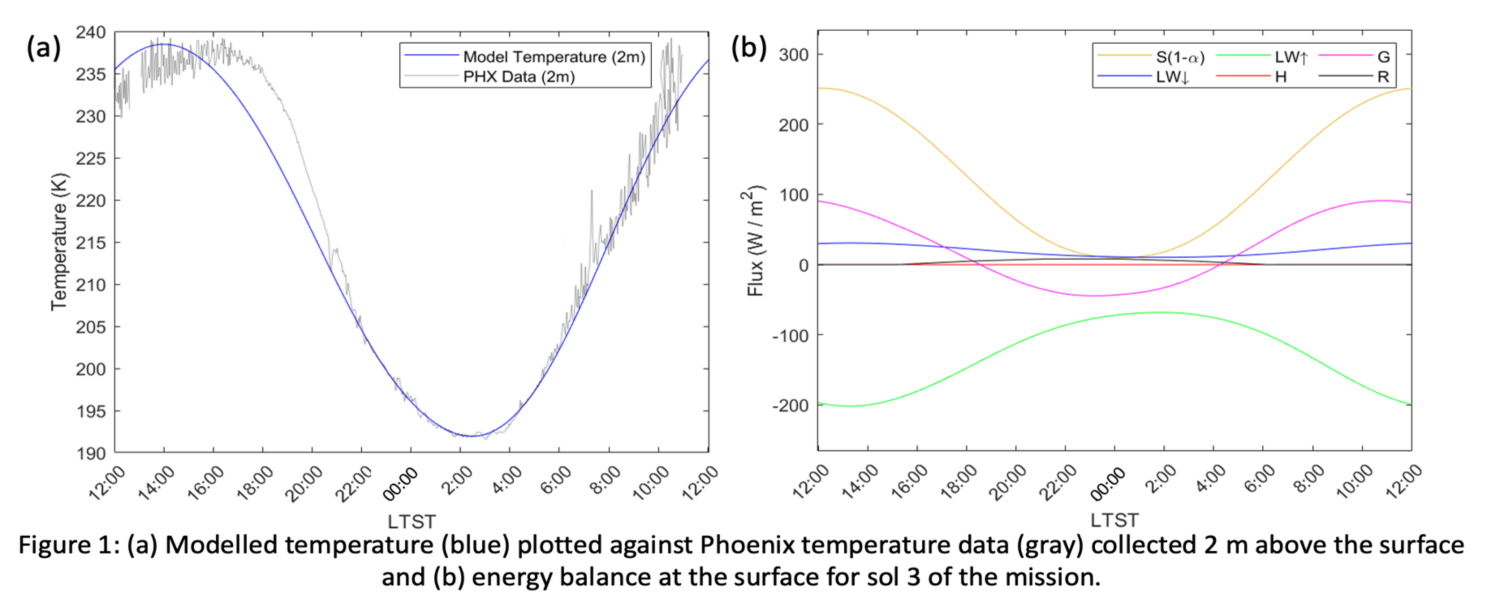- 1Centre for Research in Earth and Space Science, York University, Canada (gbischof@yorku.ca)
- 2NOIRLab, Gemini Observatory, USA
Introduction:
On Mars, near-surface and ground temperatures undergo massive diurnal fluctuations. Amplitudes can surpass 70 K between the daily maximum and minimum temperatures [1]. Because Mars’ thin atmosphere is largely transparent to infrared radiation, the solar radiation from the sun and the outgoing longwave radiation from the surface are the primary drivers of the near-surface temperature [2].
However, the influence from the atmosphere is not entirely negligible. It is well known that dust in the atmosphere has a secondary, but measurable, effect on the temperature by scattering visible-band solar radiation and absorbing longwave radiation [3]. This atmospheric thermal effect is not only caused by dust; Water-ice clouds have a similar influence, where outgoing longwave radiation may be absorbed and reflected back toward the ground, resulting in a warming of the near-surface temperature [4]. This project will investigate the amount of flux reflected by water-ice clouds by calculating the thermal forcing at the Phoenix landing site.
Background:
The Phoenix mission landed in the Martian northern Arctic, at a latitude of 68.2°N in 2008. Phoenix operated for 151 sols, collecting data up to and through the northern summer solstice. About 60 sols into the mission, water-ice clouds were observed both by images taken by the Stereo Surface Imager (SSI) [5] and by backscatter detected using a light detecting and ranging (LIDAR) instrument onboard the lander [6]. On four occasions, by using the LIDAR and SSI together, surface-fog was detected [7]. In the second half of the mission, surface-based clouds formed nightly around 23:00 Local True Solar Time (LTST). By 01:00 LTST, a second clouds base formed at altitudes near 4 km. The clouds dissipated by the late morning, but were observed to linger as the mission progressed past summer solstice [8].
Methods:
Data for the near-surface air temperature are acquired from the Planetary Data System. Phoenix carried three thin-wire temperature sensors at heights of 1 m, 0.5 m, and 0.25 m off the deck of the lander, itself located 1 m above the surface. Temperature measurements were recorded every 2 s through the duration of a sol, with an approximately 20-minute break, usually occurring around midday.
To determine the thermal impacts due to water-ice clouds, an energy balance at the surface is needed. Adapted from [9], the energy balance is given by
where G is the net flux into the ground, S is the solar radiation, α is the surface albedo, LW↓ is the longwave radiation downwelling from the atmosphere, LW↑ is the longwave radiation emitted from the surfaced, H is the sensible heat flux, and L is the latent heat flux of water. R describes the additional longwave radiation downwelling from the atmosphere, which we attribute to water-ice clouds. R is maintained as an independent parameter which may be varied throughout a run of the model in 3 hour-intervals.
With this energy balance, a subsurface conduction model is used to find the surface temperature at the Phoenix site. At each timestep, the surface temperature is coupled to the air temperature by
where the terms are described in [9].
The modelled air temperatures are plotted against the air temperature data collected by Phoenix to evaluate the additional flux reflected by clouds (given by R) that is needed for the model to match the data collected in situ.
Results and Discussion:
Figure 1(a) shows the modelled temperaure plotted against the Phoenix data for sol 3 of the mission. During the midday, R = 0 W m-2 implying there is no flux reflected from water-ice clouds. Moving into the evening, R = 5 W m-2 starting at 21:00 LTST. This increases to 8 W m-2 by 00:00 LTST. At 03:00 LTST, the reflected flux drops back down to 5 W m-2, and is back to 0 W m-2 by 06:00 LTST. This additional flux is not a dominant energy term, as shown in Figure 1(b), but a resulting temperature increase of 2 K is seen. This analysis suggests that clouds were present at the Phoenix landing site earlier than they were detected in images or LIDAR data products.

Moving forward, the amount of flux reflected by water-ice clouds will be determined for each sol of the misson. This will show how the reflected flux evolves diurnally – particularly through the nighttime – and as the mission progressed past summer solstice.
References:
[1] Martínez G.M. et al (2017) Space Sci Rev, 212, 295–338.
[2] Savijärvi H. (2014) Icarus, 242, 105–111.
[3] Guzewich S.D. et al (2019) Geophys. Res. Lett., 46, 71–79.
[4] Wilson R.J. (2007) Geophys. Res. Lett., 34.
[5] Moores J.E. et al (2010) JGR: Planets, 115.
[6] Whiteway J.A. et al (2009) Science, 325, 68–70.
[7] Moores J.E. et al (2011) Geophys. Res. Lett., 38.
[8] Dickinson C. et al (2010) Geophys. Res. Lett., 37.
[9] Martínez G.M. et al (2014) JGR: Planets, 119, 1822–1838.
How to cite: Bischof, G., Cooper, B., and Moores, J. E.: Water-Ice Cloud Thermal Effects at the Phoenix Mission Landing Site, Europlanet Science Congress 2021, online, 13–24 Sep 2021, EPSC2021-388, https://doi.org/10.5194/epsc2021-388, 2021.

